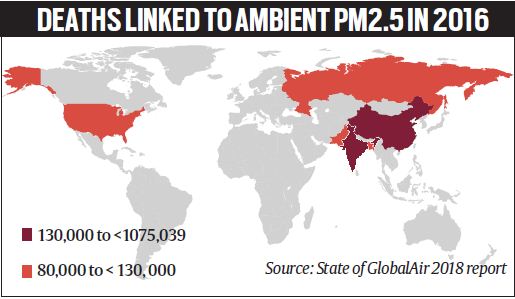- India
- International
‘India, China account for more than half of air pollution deaths’
Specific to India, the report pointed out residential biomass burning was the largest individual contributor to disease burden. Coal combustion, open burning and open burning of agricultural residue were also contributors to disease burden.
 The report states that across the world, exposure to PM 2.5 contributed to 4.1 million deaths from heart diseases and stroke, lung cancer, chronic lung disease and respiratory infections in 2016.
The report states that across the world, exposure to PM 2.5 contributed to 4.1 million deaths from heart diseases and stroke, lung cancer, chronic lung disease and respiratory infections in 2016.
The highest mortality burden due to air pollution is concentrated in Asia, with China and India accounting for more than half of the mortality burden attributed to particulate matter PM2.5, a report released by the US-based Health Effects Institute (HEI) stated. Simply put, globally for 2016, 95% of the world’s population lived in areas that exceeded the WHO Guideline for PM2.5.
“China and India had the highest numbers of deaths attributable to PM2.5. Together, these two countries accounted for 51% of the total global PM2.5-attributable deaths and 50 % of the disability-adjusted life years (DALYs),” the report noted. It also noted that 560 million people in India and 416 million in China, were exposed to household air pollution in 2016 with 43% and 30%, respectively, of their populations using solid fuels. In India, household burning of biomass was responsible for about 24% of PM2.5 levels, it noted.
The HEI’s State of Global Air 2018, which is a special report on global exposure to air pollution and its disease burden, draws on the most recent evidence (from 2016) as part of the Global Burden of Disease project of the Institute of Health Metrics and Evaluation. It presents the “latest analysis of worldwide air pollution exposures and health impacts” and is a global update on outdoor, or ambient, air pollution.
It states that across the world, exposure to PM 2.5 contributed to 4.1 million deaths from heart diseases and stroke, lung cancer, chronic lung disease and respiratory infections in 2016. Further, it noted that in 2016, “long-term exposure to ambient PM2.5 contributed to 4.1 million deaths and to a loss of 106 million DALYs, making PM2.5 exposure responsible for 7.5% of all global deaths and 4.4% of all global DALYs.” Ozone contributed to 234,000 deaths from chronic lung disease.

The report notes that even though China experienced substantial increases in population-weighted exposure before 2010, which the report attributes partly to dramatic scale of economic development in the country, it notes that “since then the exposures have stabilised and even begun to decline slightly.” However, South Asian countries like Pakistan, Bangladesh and India, “have experienced the steepest increases in air pollution levels since 2010 and now present the highest sustained PM2.5 concentrations among the countries” shown in the report, it states.

Specific to India, the report pointed out residential biomass burning was the largest individual contributor to disease burden. “Residential biomass burning was responsible for 267,700 deaths or nearly 25% of the deaths attributable to PM2.5, making it the most important single anthropogenic source related to mortality in 2015. These burden estimates do not include the considerable additional burden from indoor exposure to biomass burning in the home,” it noted.
Coal combustion, open burning and open burning of agricultural residue were also contributors to disease burden.
Buzzing Now
Apr 20: Latest News
- 01
- 02
- 03
- 04
- 05






























